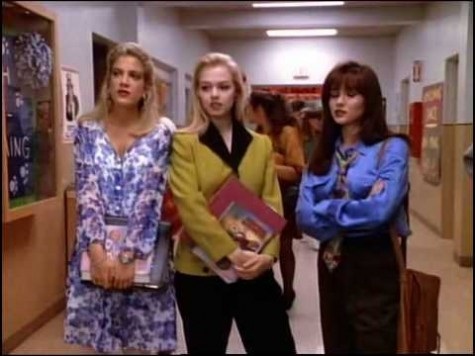Good evening everybody. Hope you had a wonderful day. Tomorrow is going to be an exciting day around here, so try and get some rest. Let me help you out.
Not sleepy? Me neither. Fuck it!
Someone grab me a damn beer.
Good evening everybody. Hope you had a wonderful day. Tomorrow is going to be an exciting day around here, so try and get some rest. Let me help you out.
Not sleepy? Me neither. Fuck it!
Someone grab me a damn beer.
Picture of the night is a new feature we may occasionally post. Tonight your job is to guess what this map is showing (other than the ol’ US of A).
Since our theme makes the header image stretched and small, here is a higher resolution image, click to enlarge.

Our winner is slackjawed_yoda. This map is the broadband availability as reported by BroadbandMap.gov. Now the next time you think high speed internet access is a Dog given right just remember that if your home is in the middle of nowhere you still have very limited options for accessing Crasstalk.
Good evening. Hope you had a great day, and are getting ready for the weekend. Lord knows I am. Here’s a little bit of The King for your evening.
Have a great night.
PhotoPhriday started on a whim: while chatting in Crosstalk on TSTSNBN, I suggested we share pictures of our personal living spaces. A few people were game (if memory serves, Matty McBoy’s reply was, “I’m game”) and the photo sharing began.
We had such a good time peeking into the lives of our friends and neighbors that we turned it into a real game. Since then, we’ve shared pictures of ourselves, our shame, our art, our travels. Best of all, it is a great way to get to know the amazing people with whom we share our online time.
The rules are few:
Oh, and the spelling? It is one word, no space, because it had to work as a tag on the old site: #photophriday (#pourafortyonthefloor), and it is misspelled because I was trying to be cute. Now we’re stuck with it and every time I see it, I think, “phuck.”
This week’s host is DogsOfWar. He dropped no hints about the theme, but I’m pretty sure it won’t be about clouds.
Our wonderful colleague Salome Valentine, hot on the heels of this week’s ruling in Snyder v. Phelps (holding WBC’s picketing of a military funeral to be Constitutionally-protected speech), highlighted an earlier decision by this Court dealing with a similar issue. As correctly noted by her, in US v. Stevens, the Supreme Court struck down a 1999 law that outlawed “crush videos” – despicable videos that show the torment and death of animals whereby a (typically small) animal is crushed by a woman, done for the sexual (masturbatory) gratification. I do not understand this fetish. Few do and it appears to fall so far outside the bounds of ordinary human decency – and even depravity – that few are willing to discuss it in depth or at length.
Nevertheless, the Supreme Court struck down a law that outlawed these videos, seeming to put the imprimatur of permissibility out conduct that falls well beyond the pale. This is not true. In fact, what Chief Justice John Roberts’ opinions in both Stevens and Snyder show is a deep abiding devotion to the letter and spirit of the First Amendment. This devotion is apparent in the plain-spoken and highly accessible manner in which Justice Roberts wrote his opinions.
I have excerpted the notable and relevant portions of Roberts’ opinions. Once you read them, I hope you will see that, at least when it comes to the First Amendment, John Roberts is a needed bulwark against the likes of Samuel Alito. Where you see quotes, that is Justice Roberts citing to a prior case. I have omitted the cited case names and citations for brevity’s sake because Justice Roberts does, in fact, hew close to prior rulings:
Whether the First Amendment prohibits holding Westboro liable for its speech in this case turns largely on whether that speech is of public or private concern, as determined by all the circumstances of the case. “[S]peech on ‘matters of public concern’ . . . is ‘at the heart of the First Amendment’s protection.’” The First Amendment reflects “a profound national commitment to the principle that debate on public issues should be uninhibited, robust, and wide-open.” That is because “speech concerning public affairs is more than self-expression; it is the essence of self-government.” Accordingly, “speech on public issues occupies the highest rung of the hierarchy of First Amendment values, and is entitled to special protection.”
The “content” of Westboro’s signs plainly relates to broad issues of interest to society at large, rather than matters of “purely private concern.” While these messages may fall short of refined social or political commentary, the issues they highlight—the political and moral conduct of the United States and its citizens, the fate of our Nation, homosexuality in the military, and scandals involving the Catholic clergy—are matters of public import. The signs certainly convey Westboro’s position on those issues, in a manner designed… to reach as broad a public audience as possible. And even if a few of the signs—such as “You’re Going to Hell” and “God Hates You”—were viewed as containing messages related to Matthew Snyder or the Snyders specifically, that would not change the fact that the overall thrust and dominant theme of Westboro’s demonstration spoke to broader public issues.
Westboro had been actively engaged in speaking on the subjects addressed in its picketing long before it became aware of Matthew Snyder, and there can be no serious claim that Westboro’s picketing did not represent its “honestly believed” views on public issues. There was no preexisting relationship or conflict between Westboro and Snyder that might suggest Westboro’s speech on public matters was intended to mask an attack on Snyder over a private matter.
Westboro conducted its picketing peacefully on matters of public concern at a public place adjacent to a public street. Such space occupies a “special position in terms of First Amendment protection.” “[W]e have repeatedly referred to public streets as the archetype of a traditional public forum,” noting that “ ‘[t]ime out of mind’ public streets and sidewalks have been used for public assembly and debate.”
That said, “[e]ven protected speech is not equally permissible in all places and at all times.” Westboro’s choice of where and when to conduct its picketing is not beyond the Government’s regulatory reach—it is “subject to reasonable time, place, or manner restrictions” that are consistent with the standards announced in this Court’s precedents.
Maryland’s law, however, was not in effect at the time of the events at issue here, so we have no occasion to consider how it might apply to facts such as those before us, or whether it or other similar regulations are constitutional.
Simply put, the church members had the right to be where they were. Westboro alerted local authorities to its funeral protest and fully complied with police guidance on where the picketing could be staged. The picketing was conducted under police supervision some 1,000 feet from the church, out of the sight of those at the church. The protest was not unruly; there was no shouting, profanity, or violence.
The record confirms that any distress occasioned by Westboro’s picketing turned on the content and viewpointof the message conveyed, rather than any interference with the funeral itself. A group of parishioners standing at the very spot where Westboro stood, holding signs that said “God Bless America” and “God Loves You,” would not have been subjected to liability. It was what Westboro said that exposed it to tort damages.
Given that Westboro’s speech was at a public place on a matter of public concern, that speech is entitled to “special protection” under the First Amendment. Such speech cannot be restricted simply because it is upsetting or arouses contempt. “If there is a bedrock principle underlying the First Amendment, it is that the government may not prohibit the expression of an idea simply because society finds the idea itself offensive or disagreeable.” Indeed, “the point of all speech protection is to shield just those choices of content that in someone’s eyes are misguided, or even hurtful.”
“in public debate [we] must tolerate insulting, and even outrageous, speech in order to provide adequate ‘breathing space’ to the freedoms protected by the First Amendment.”
What Westboro said, in the whole context of how and where it chose to say it, is entitled to “special protection” under the First Amendment, and that protection cannot be overcome by a jury finding that the picketing was outrageous. For all these reasons, the jury verdict imposing tort liability on Westboro for intentional infliction of emotional distress must be set aside.
In most circumstances, “the Constitution does not permit the government to decide which types of otherwise protected speech are sufficiently offensive to require protection for the unwilling listener or viewer. Rather, . . . the burden normally falls upon the viewer to avoid further bombardment of [his] sensibilities simply by averting [his] eyes.”
As a general matter, we have applied the captive audience doctrine only sparingly to protect unwilling listeners from protected speech. For example, we have upheld a statute allowing a homeowner to restrict the delivery of offensive mail to his home and an ordinance prohibiting picketing “before or about” any individual’s residence.
Here, Westboro stayed well away from the memorial service. Snyder could see no more than the tops of the signs when driving to the funeral. And there is no indication that the picketing in any way interfered with the funeral service itself. We decline to expand the captive audience doctrine to the circumstances presented here. Because we find that the First Amendment bars Snyder from recovery for intentional infliction of emotional distress or intrusion upon seclusion—the alleged unlawful activity Westboro conspired to accomplish—we must likewise hold that Snyder cannot recover for civil conspiracy based on those torts.
Our holding today is narrow.
Westboro believes that America is morally flawed; many Americans might feel the same about Westboro. Westboro’s funeral picketing is certainly hurtful and its contribution to public discourse may be negligible. But Westboro addressed matters of public import on public property, in a peaceful manner, in full compliance with the guidance of local officials. The speech was indeed planned to coincide with Matthew Snyder’s funeral, but did not itself disrupt that funeral, and Westboro’s choice to conduct its picketing at that time and place did not alter the nature of its speech.
Speech is powerful. It can stir people to action, move them to tears of both joy and sorrow, and—as it did here—inflict great pain. On the facts before us, we cannot react to that pain by punishing the speaker. As a Nation we have chosen a different course—to protect even hurtful speech on public issues to ensure that we do not stifle public debate. That choice requires that we shield Westboro from tort liability for its picketing in this case.
From US v. Stevens:
“From 1791 to the present,” however, the First Amendment has “permitted restrictions upon the content of speech in a few limited areas,” and has never “include[d] a freedom to disregard these traditional limitations.” These “historic and traditional categories long familiar to the bar,” – including obscenity, defamation, fraud, incitement, and speech integral to criminal conduct —are “well-defined and narrowly limited classes of speech, the prevention and punishment of which have never been thought to raise any Constitutional problem.
The Government argues that “depictions of animal cruelty” should be added to the list. It contends that depictions of “illegal acts of animal cruelty” that are “made, sold, or possessed for commercial gain” necessarily “lack expressive value,” and may accordingly “be regulated as unprotected speech.” The claim is not just that Congress may regulate depictions of animal cruelty subject to the First Amendment, but that these depictions are outside the reach of that Amendment altogether— that they fall into a “`First Amendment Free Zone.'”
As the Government notes, the prohibition of animal cruelty itself has a long history in American law, starting with the early settlement of the Colonies. Reply Brief 12, n. 8; see, e.g., The Body of Liberties § 92 (Mass. Bay Colony 1641) (“No man shall exercise any Tirany or Cruelty towards any bruit Creature which are usually kept for man’s use“). But we are unaware of any similar tradition excluding depictions of animal cruelty from “the freedom of speech” codified in the First Amendment, and the Government points us to none.
Instead, the Government points to Congress’s “`legislative judgment that . . . depictions of animals being intentionally tortured and killed [are] of such minimal redeeming value as to render [them] unworthy of First Amendment protection,'” and asks the Court to uphold the ban on the same basis. The Government thus proposes that a claim of categorical exclusion should be considered under a simple balancing test: “Whether a given category of speech enjoys First Amendment protection depends upon a categorical balancing of the value of the speech against its societal costs.”
As a free-floating test for First Amendment coverage, that sentence is startling and dangerous. The First Amendment’s guarantee of free speech does not extend only to categories of speech that survive an ad hoc balancing of relative social costs and benefits. The First Amendment itself reflects a judgment by the American people that the benefits of its restrictions on the Government outweigh the costs. Our Constitution forecloses any attempt to revise that judgment simply on the basis that some speech is not worth it. The Constitution is not a document “prescribing limits, and declaring that those limits may be passed at pleasure.” Marbury v. Madison, 1 Cranch 137, 178, 2 L.Ed. 60 (1803).
We read § 48 to create a criminal prohibition of alarming breadth. To begin with, the text of the statute’s ban on a “depiction of animal cruelty” nowhere requires that the depicted conduct be cruel. That text applies to “any . . . depiction” in which “a living animal is intentionally maimed, mutilated, tortured, wounded, or killed.” § 48(c)(1). “[M]aimed, mutilated, [and] tortured” convey cruelty, but “wounded” or “killed” do not suggest any such limitation.
The only thing standing between defendants who sell such depictions and five years in federal prison—other than the mercy of a prosecutor—is the statute’s exceptions clause. Subsection (b) exempts from prohibition “any depiction that has serious religious, political, scientific, educational, journalistic, historical, or artistic value.” The Government argues that this clause substantially narrows the statute’s reach: News reports about animal cruelty have “journalistic” value; pictures of bullfights in Spain have “historical” value; and instructional hunting videos have “educational” value.
Quite apart from the requirement of “serious” value in § 48(b), the excepted speech must also fall within one of the enumerated categories. Much speech does not. Most hunting videos, for example, are not obviously instructional in nature, except in the sense that all life is a lesson. According to Safari Club International and the Congressional Sportsmen’s Foundation, many popular videos “have primarily entertainment value” and are designed to “entertai[n] the viewer, marke[t] hunting equipment, or increas[e] the hunting community.” The Government offers no principled explanation why these depictions of hunting or depictions of Spanish bullfights would be inherently valuable while those of Japanese dogfights are not. The dissent contends that hunting depictions must have serious value because hunting has serious value, in a way that dogfights presumably do not. Post, at ___-___. But § 48(b) addresses the value of the depictions, not of the underlying activity. There is simply no adequate reading of the exceptions clause that results in the statute’s banning only the depictions the Government would like to ban.
This prosecution is itself evidence of the danger in putting faith in government representations of prosecutorial restraint. When this legislation was enacted, the Executive Branch announced that it would interpret § 48 as covering only depictions “of wanton cruelty to animals designed to appeal to a prurient interest in sex.” See Statement by President William J. Clinton upon Signing H.R. 1887, 34 Weekly Comp. Pres. Doc. 2557 (Dec. 9, 1999). No one suggests that the videos in this case fit that description. The Government’s assurance that it will apply § 48 far more restrictively than its language provides is pertinent only as an implicit acknowledgment of the potential constitutional problems with a more natural reading.
Again, in Stevens, Justice Alito was the lone dissent.
Does the Supreme Court love or even approve of animal cruelty or the needless infliction of emotional anguish on a grieving parent? Not one jot. What Justice Stevens’ opinion show is compassion and desire for a moral society in America that is governed equally before the law.
Please read these opinions if you get a chance. They are written in plain English and speak volumes to just how valuable the First Amendment is. I find myself revisiting my prejudices towards Justice Roberts, based on him being appointed by President George W. Bush. In reading these two cases, I am glad to see that someone of his intellect is, in fact, safeguarding the First Amendment.
Good afternoon. Hope your day is coming along nicely and that you had time for a nice lunch.
This is Cooking with the Dog. Just the title should tell you how awesome it is.
Have a great afternoon.
Important Announcement! Word Press and Intense Debate are the target of DDos attacks today. There are probably going to be some outages, but hopefully they will get it under control soon. Courage!
CORRECTION: I got the basic source information for this article from an email I received from one of many animal rights groups I belong to. I did not thoroughly investigate the message, because this ruling happened on Tuesday, April 20, 2010, not earlier this week, as I stated.
Thank you to everyone who corrected me, and many apologies for my error. This is why I do not usually write news posts.
On April 20, 2010, the United States Supreme Court struck down a 1999 federal law banning animal cruelty – or “crush” – videos, showing the actual killing of cats, dogs and other small animals by stomping or other intensely cruel methods. The killings are filmed, and the DVDs are then sold to fetishists.
The Court, which voted 8-1 to strike down the law, based its decision on the fact that the 1999 law, which was passed by Congress, was too broad. Justice Samuel Alito was the only voice of reason and common decency dissenting vote. He insisted that banning the sale of crush videos was essential to stop people from abusing the animals.
For more information, see the PBS.org article, which includes a link to the complete SCOTUS decision.
If you’d like to donate to an animal protection organizations, here are some links:
www.aspca.org – ASPCA
www.humanesociety.org – Humane Society
www.aldf.org – Animal Legal Defense Fund
You can’t talk about the ’90s fashion revival without mentioning Beverly Hills, 90210. Today’s designers are taking more than a little inspiration from the halls of West Beverly – many of their clothes seem to be taken directly from the angsty teen with a heart of gold, Brenda Walsh. From Minnesota to LA, Brenda had the perfect ensemble for any locale or occasion. Here’s how to make a few of them your own.
June will be here any minute now. You’ll need to look your best when you frolic on the beach, and nothing says summer fun like soggy denim. You, too, can rock Brenda’s beach look above. First, pick your shade of choice from American Apparel’s many-colored Stretch Twill High-Waist Side Zipper Shorts. Let’s go with Butternut. Next, pair it with JCrew’s Stripe Button-Back Tee. According to the site, the tee is their It Silhouette of the season and everyone’s just mad over its “new boxy shape.”
To tie the ensemble together, you’re going to need a statement piece. Nothing says HBIC of the BHBC (Beverly Hills Beach Club) like a chunky belt buckle. This Melamed Vine-Buckle Belt from Sak’s is pricey, but looking better than that bitch Kelly doesn’t come cheap.
What if you’re traveling abroad and want to scream “sophisticated polyglot”? It won’t matter if your French accent is lacking when you’re wearing a chic peekaboo ensemble. Because when Jacques leans in and whispers “I can see your bra,” what he’s really saying is “Je t’aime.”
Brenda mastered the femme fatale look here:

You can make it your own by pairing Urban Outfitter’s Pins and Needles Long-Sleeved Lace Top with the wide-strapped Vanity Fair Illuminations Bralette.


Warning: With a look this hot, Kelly will steal your style faster than she can steal your boyfriend.
Being a teenager is hard. Sometimes Brenda had the weight of the world on her shoulders; other times, it was the weight of her blazer wearing her down.
Power shoulders cost power bucks. Try this strong-shouldered Paul and Joe blazer with shawl lapel for $254.11 from The Outnet. Balance those bold shoulders with Urban Outfitter’s whimsical Square-Knot Headband.


Some people may say Levi’s Relaxed Tapered 550 Jeans are more “mom jeans” than “California teen dream jeans,” but a certain summer of ’91 pregnancy scare reminded us that the two aren’t mutually exclusive.
Of all her varied looks, you could argue that menswear chic is the Quintessential Brenda. Tons of brands let you sport this look today even if you don’t have a twin brother’s closet to raid.

If your mother is a TV icon and money’s no object, Paul Smith’s Spring Summer 2011 Collection will meet all your menswear needs. The line features oversized, jewel-toned suits, in addition to the Bengal striped classic shirt, Tromp L’oeil trousers and spot silk tie shown below. Ditch the polka dot tie for something more colorful and fun, like this Stefano Ricci Patchwork Mixed-Design Tie, available at Neiman Marcus for $635.


If you’ll be picking up extra shifts at the diner to finance your glam ambitions, don’t fret.

Stop by American Apparel instead and pick up their Unisex Denim Long Sleeved Button-Up Shirt and Micro-Poly High-Waist Pleated Pant. Then, head over to KMart and pick up a multi-toned Structure Paisley Tie.



All that’s left to do is hit the malls. If you keep these tips in mind, you’ll never spend the morning stressing over the perfect outfit again:
Everyone knows that inevitably some day soon the virus that turns humans into zombies will be created through a mishap of evolution, God and modern science’s desire to constantly dick around with shit. When that day comes humanity will be faced with a choice: to act quickly to contain the virus or dither and allow it to tear through the human race like Gore-nado from hell. It will be down to the authorities at hand when patient zero is infected to effectively contain the virus. Popular culture tells us that government secrecy and bureaucratic incompetence are to be involved in any failure to contain the virus.
So we may hope that the outbreak takes place in Boston as this twitter exchange reveals that the Boston PD remains committed to be being forthcoming with information about any zombie attacks.
Via Neatorama
The 8 bit NES homebrew/modding scene is at it again. Not content at modding an NES to fit in to a Genesis, or modding an NES to fit in to PC, some guy got to hacking a breathalyzer in to an NES cartridge. You’ve been blowing on the cartridges forever (the only way to make them work, duh.) I already know that the only time you feel like playing Zelda is when you’re drunk (or depressed. You want to feel a sense of accomplishment, so you beat Zelda in 3 hours, for the 93rd time. But you’re depressed, so you’re probably drunk too.) So modding a breathalyzer in to an NES cart is actually a good idea. Function and form come together in perfect symmetry, yet again! This is actually sort of impressive because he coded a cartridge to display your score etc. Getting the “party frog” is the equivalent in getting the Soyuz rocketship in Tetris. Hah! Not really! Getting the “party frog” only tells your friends what they know and you’re hopelessly in denial about: You’re a drunk!